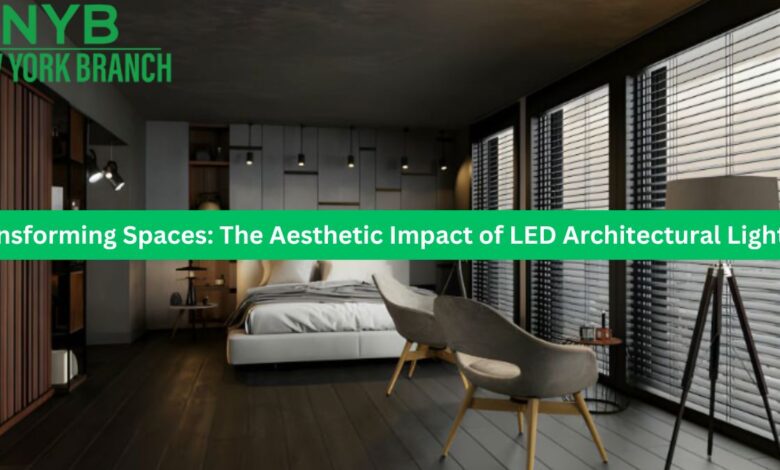Transforming Spaces: The Aesthetic Impact of LED Architectural Lighting

In recent years, the integration of LED architectural lighting has revolutionized the way we perceive and experience spaces. From grand facades of iconic buildings to intimate interiors of homes, LED lighting has become a fundamental tool for architects, designers, and artists alike.
This innovative technology not only provides efficient illumination but also offers a plethora of creative possibilities to transform environments into visually stunning landscapes. In this article, we delve into the aesthetic impact of LED architectural lighting and explore how it has reshaped our understanding of spatial design.
The Evolution of Lighting Technology
Before the advent of architectural lighting, traditional sources such as incandescent and fluorescent bulbs dominated the market. However, these conventional options were limited in terms of energy efficiency, lifespan, and design flexibility.
LED (Light Emitting Diode) technology emerged as a game-changer, offering numerous advantages over its predecessors. LEDs consume significantly less energy, have a longer lifespan, and are available in various colors and shapes. Moreover, their compact size and durability make them ideal for architectural applications, both indoors and outdoors.
Enhancing Architectural Features architectural lighting
One of the key benefits of LED architectural lighting is its ability to accentuate the inherent beauty of architectural elements.
Whether it’s the intricate architectural lighting detailing of a historic building or the sleek lines of a modern structure, LED lighting can highlight these features with precision and elegance. By strategically placing light fixtures, architects and designers can create dramatic effects that draw attention to specific areas or create a sense of depth and dimensionality.
Illuminating Facades
LED lighting has become a popular choice for illuminating building facades, transforming them into dynamic works of art. By washing walls with vibrant colors or outlining architectural contours with subtle gradients of light, designers can enhance the visual impact of structures, particularly during nighttime.
This not only adds to the aesthetic appeal of the building but also contributes to its identity within the urban landscape.
Creating Ambiance and Mood
Lighting plays a crucial role in shaping the ambiance and mood of a space. Buy Rite Electric offers a wide range of LED architectural lighting solutions, providing unparalleled versatility. Designers can manipulate color, intensity, and direction to evoke specific emotions and atmospheres.
Whether it’s a warm and inviting glow for a cozy restaurant or a vibrant spectrum of hues for a lively nightclub, LED lighting can be tailored to suit the desired mood and enhance the overall experience of occupants.
Dynamic Lighting Control
With advancements in lighting control systems, such as DMX and DALI protocols, designers have greater flexibility in programming dynamic lighting sequences.
This enables seamless transitions between different lighting scenes, creating immersive environments that respond to the changing needs of users. For instance, in a retail setting, LED lighting can be synchronized with music and visuals to enhance product displays and entice customers.
Sustainability and Energy Efficiency
In an era of increasing environmental awareness, sustainability has become a paramount concern in architectural design.
LED lighting addresses this challenge by offering superior energy efficiency and environmental performance compared to traditional lighting technologies.
LEDs consume up to 80% less energy and emit fewer greenhouse gases, making them a more eco-friendly option for illuminating spaces. Additionally, their long lifespan reduces the frequency of replacements, further reducing waste and resource consumption.
Green Building Certification
Many modern architectural projects aim to achieve green building certification, such as LEED (Leadership in Energy and Environmental Design), which recognizes sustainable design practices.
LED lighting installations contribute to these efforts by fulfilling criteria related to energy efficiency, indoor environmental quality, and innovation.
By incorporating LED technology into their projects, architects can demonstrate their commitment to environmental stewardship and responsible design.
Pushing the Boundaries of Design Innovation
As LED technology continues to evolve, designers are pushing the boundaries of innovation to create increasingly immersive and interactive lighting experiences.
From interactive installations that respond to user input to dynamic façade systems that adapt to changing environmental conditions, LED architectural lighting is enabling new forms of creative expression.
By integrating sensors, actuators, and advanced control algorithms, designers can transform static environments into dynamic and responsive spaces that engage the senses and foster deeper connections with occupants.
Bridging Technology and Culture
LED architectural lighting has also become a powerful tool for bridging technology and culture, enabling designers to incorporate cultural motifs, traditions, and narratives into their lighting designs.
By drawing inspiration from local heritage, folklore, and symbolism, designers can create lighting installations that resonate with the cultural identity of a place, fostering a sense of pride and belonging among communities.
Whether it’s illuminating historical landmarks with traditional patterns or celebrating cultural festivals with vibrant displays of light, LED lighting serves as a medium for cultural expression and celebration.
Conclusion
In conclusion, LED architectural lighting has transformed the way we perceive and experience spaces, offering endless possibilities for creative expression and innovation.
From enhancing architectural features to shaping ambiance and mood, LED technology has become an indispensable tool for designers seeking to create immersive and memorable environments.
As we look to the future, the continued evolution of LED lighting holds promise for even greater advancements in design, sustainability, and cultural expression. By harnessing the power of light, we can illuminate the path towards a brighter, more vibrant future for architecture and design.



